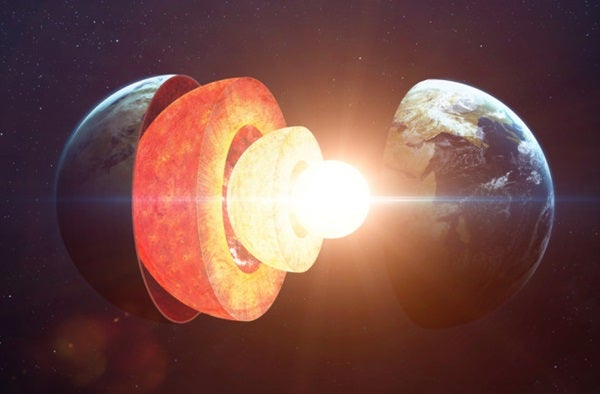Earth’s core has long been a place of mystery to scientists. The core of our planet sits just over 1,800 miles below the surface and exists as a ball of seething hot metal, specifically iron and nickel. It possesses many unique qualities — including its own spin.
Now, researchers at Peking University in China have released new findings about Earth’s inner core: its spin rate has slowed. Here are three things you need to know about their study, as well as what the results mean for us on the surface.
1. The inner core’s rotation may be slowing down and reversing course.
According to the results of the study, which was published in Nature Geoscience, Earth’s core may be reversing its rotation. Its rotation has slowed significantly, and this slowing began all the way back in 2009.
“We show surprising observations that indicate the inner core has nearly ceased its rotation in the recent decade,” writes researchers Yi Yang and Xiaodong Song in their study. “[Our] observations suggest not only a pause, but also a turning-back of the rotation by a small amount.”
Prior to these new findings, Earth’s core was thought to have been spinning at a faster rate than Earth’s crust. These differences in spin are likely due to the gravitational effect that Earth’s mantle has on the inner core, as well as the magnetic field that is generated by Earth’s outer core.
2. These findings may suggest a larger pattern at work.
Since scientists are still learning more about Earth’s core, it is difficult to uncover how it has operated in the past. However, the study’s results revealed that a larger, decade-long pattern may be at play.
By examining data that stretches back to the 1960s, Yang and Song discovered that the rotation of Earth’s inner core was consistent from the late 1970s to the early 2000s. Before that, though, they found that another possible slowing down or reversal event may have occurred in Earth’s inner core in the early 1970s.
“The rotation is not purely steady, with a significant rate [of spin] in the earlier decades but a much smaller rate in the most recent decade and in the 1960s to 70s,” they write in the study.
In other words, the inner core’s rotation seems to vary on a decade-long timescale, with it speeding up, slowing down and possible reversing course over a period of time. Song and Yang estimate that the switches occur every seven decades or so.
3. No, the world isn’t ending.
While it may seem like these results would have a huge impact to life on the surface, we haven’t felt anything just yet.
“Nothing cataclysmic is happening,” said Hrvoje Tkalcic, a geophysicist at Australian National University, in an interview with CNN. “The inner core is now more in sync with the rest of the planet than a decade ago when it was spinning a bit faster.”
According to the study, small changes in the strength of Earth’s electromagnetic field, as well as the gravitational effect that the mantle has on the inner core, would be enough to alter the inner core’s rate of rotation. Once again, though, these changes do not impact life on Earth’s surface much, if at all.
However, both Song and Yang conclude that more research is needed. And with how mysterious the core of our planet is, it’s likely that there’s far more to discover.










